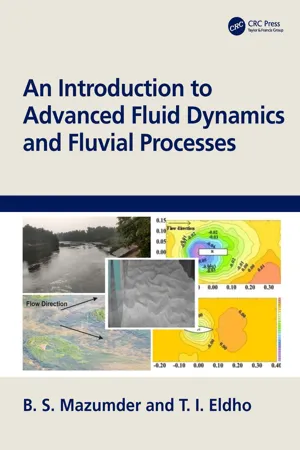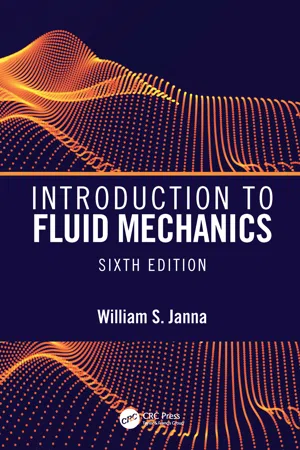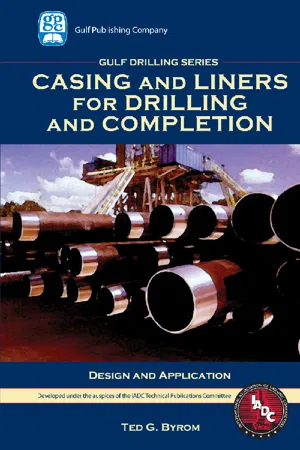Physics
Fluid Systems
Fluid systems refer to a collection of interconnected components that work together to transport and control the flow of fluids, such as liquids and gases. These systems are governed by principles of fluid mechanics and can be found in various applications, including hydraulic systems, pipelines, and ventilation systems. Understanding fluid systems is crucial for designing and optimizing fluid-based technologies.
Written by Perlego with AI-assistance
Related key terms
10 Key excerpts on "Fluid Systems"
- B. S. Mazumder, T. I. Eldho(Authors)
- 2023(Publication Date)
- CRC Press(Publisher)
2 Fundamental Fluid Properties and DefinitionsDOI: 10.1201/9781003000020-22.1 Introduction
Fluid mechanics is a branch of physics concerned with the mechanics of fluid flows. The study of fluid flow has been described with the support of fundamental laws of mechanics (Schlichting, 1968) . It has a wide range of applications in almost all branches of engineering fields including civil engineering, mechanical engineering, chemical engineering, aerospace engineering, agriculture engineering, ocean engineering, and others. Apart from the engineering profession, the principles of fluid mechanics are also used in all branches of sciences such as geophysics, astrophysics, physical chemistry, biomechanics, biomedical, meteorology, atmospherics, etc. It is one of the fastest rising basic sciences whose principles show applications in all aspects of daily life. For example, in civil engineering, the principles of fluid mechanics are used to design drainage systems, water networks, water-resisting structures such as dams and reservoirs, construction and foundation of bridge piers, river bank protection, river management, protection of coastal and harbor areas, etc. Moreover, designs of various types of ships, recreation boats, and barges or vessels for transportation in rivers and oceans associated with the field of naval architecture are based on the principles of fluid mechanics.The study of fluid behavior can be divided into three categories: statics, kinematics, and dynamics. In the static case, the fluid elements are acted upon by the forces at rest. The static pressure forces on an immersed body in fluid are determined from the static analysis. In the case of kinematics of fluids, it deals with the geometry of fluid motion: study of translation, rotation, and deformation of fluid particles. This is useful for describing the motion of a particle and visualizing the flow patterns. In the dynamic case, the analysis involves considering the forces acting on the fluid particles in motion with respect to one another that cause acceleration of fluid. To determine the fluid flow pattern and its surroundings in motion, the dynamic analysis of a fluid in motion is required. In this chapter, the description of fundamental fluid properties and a fundamental definition of various terms used in fluid dynamics and fluvial hydraulics are briefly discussed.- eBook - ePub
- D. Kumar, Sarhan M. Susa(Authors)
- 2022(Publication Date)
- Mercury Learning and Information(Publisher)
5FLUID MECHANICSFluid Mechanics is basically a study of thei. physical behavior of fluids and Fluid Systems, and of the laws governing this behavior,ii. action of forces on fluids and of the resulting flow pattern.Fluid mechanics may be divided into three divisions:1. Hydrostatics that studies the mechanics of fluids at absolute and relative rest; the fluid elements are free from shearing stresses.2. Kinematics that deals with translation, rotation, and deformation of fluid elements without considering the force and energy causing such a motion.3. Dynamics that prescribes the relations between velocities and accelerations and the forces which are exerted by or upon the moving fluids.After reading this chapter, the reader would be able toi. make distinction between the three states of matter (solid, liquid, and gas).ii. understand the concept of a fluid, real and ideal fluid.iii. make a brief review about the development of the exciting and fascinating subject of fluid mechanics.iv. appreciate the unlimited practical applications of fluid mechanics.5.1. SOLIDS, LIQUIDS, AND GASESMatter exists in two principal forms: solid and fluid. Fluid is further subdivided into liquid and gas. Distinguishing features among these are as follows:i. The solids, liquids, and gases exhibit different characteristics on account of their different molecular structure. Spacing and the latitude of the motion of molecules are large in a gas, small in a liquid, and extremely small in a solid. Accordingly, the inter-molecular bonds are very weak in a gas, weak in a liquid, and very strong in a solid. It is due to these aspects that solid is very compact and rigid in form, liquid accommodates itself to the shape of its container, and gas fills up the whole of the vessel containing it.ii. For a given mass, the liquids have a definite volume irrespective of the size of the container. The variation of volume with temperature and pressure is insignificant. Liquid occupies the vessel fully or partially depending on its mass, and it forms a free surface with the atmosphere. The gas, however, expands to fill any vessel in which it is contained and does not form any free surface. Accordingly, it may be stated: The solid has volume and shape; a liquid has volume but no shape; a gas has neither - eBook - ePub
- A. L. Stanford, J. M. Tanner(Authors)
- 2014(Publication Date)
- Academic Press(Publisher)
9 Mechanics of Fluids Publisher Summary This chapter describes the properties of fluids that permit an analysis of their mechanics and the introduction of pressure, a quantity that is useful in considering the way in which forces may affect fluids and in which fluids exert forces. A practical application of fluid statics is the use of Pascal’s law, which treats the transmission of pressure in confined fluids (hydraulic systems). At the microscopic level, all matter is composed of particles that are constantly in random motion. The particles in a solid are strongly bound together; their random motion is confined to jiggling about equilibrium positions that are virtually fixed relative to each other. Thus, solids are relatively rigid. The particles in a gas essentially interact only during brief, intense collisions with other particles of the gas or with the walls of their container. The motion of particles in a liquid is random but not as chaotic as the motion of particles of a gas. The attractive forces between particles in a liquid are sufficiently strong on the average to make the liquid cohesive yet are weak enough to permit the liquid to flow. In flowing, the particles of the liquid pass one another easily without macroscopic separation of the mass of liquid. Fluids are either liquids or gases. They are characterized by physical properties that distinguish them from solids. In this chapter we will first describe the properties of fluids that permit us to analyze their mechanics and then introduce pressure, a quantity that is useful in considering how forces may affect fluids and how fluids exert forces. Pressure will be useful in studying fluid statics, that is, fluids at rest, as contrasted with fluid dynamics, the study of fluids in motion. Fluid statics entails the interaction of fluids with their containers, with other fluids, and with solids. Included in the study of statics is the physics of buoy ancy, a practical aspect of fluid studies - eBook - ePub
- William S. Janna(Author)
- 2020(Publication Date)
- CRC Press(Publisher)
1 Fundamental ConceptsFluid mechanics is the branch of engineering that deals with the study of fluids—both liquids and gases. Such a study is important because of the prevalence of fluids and our dependence on them. The air we breathe, the liquids we drink, the water transported through pipes, and the blood in our veins are examples of common fluids. Further, fluids in motion are potential sources of energy that can be converted into useful work—for example, by a waterwheel or a windmill. Clearly, fluids are important, and a study of them is essential to the engineer.After completing this chapter, you should be able to:- Describe commonly used unit systems;
- Define a fluid;
- Discuss common properties of fluids;
- Establish features that distinguish liquids from gases; and
- Present the concept of a continuum.
1.1 DIMENSIONS AND UNITS
Before we begin the exciting study of fluid mechanics, it is prudent to discuss dimensions and units. In this text, we use two unit systems: the British gravitational system and the international system (SI). Whatever the unit system, dimensions can be considered as either fundamental or derived. In the British system, the fundamental dimensions are length, time, and force. The units for each dimension are given in the following table:
Mass is a derived dimension with units of slug and defined in terms of the primary dimensions asBritish Gravitational SystemDimensionAbbreviationUnitLength L foot (ft) Time T second (s) Force F pound-force (lbf)
Converting from the unit of mass to the unit of force is readily accomplished because the slug is defined in terms of the lbf (pound-force).1 slug = 11 bf ⋅fts 2(1.1) Example 1.1 An individual weighs 150 lbf.- a. What is the person’s mass at a location where the acceleration due to gravity is 32.2 ft/s2 ?
- b. On the moon, the acceleration due to gravity is one-sixth of that on earth. What is the weight of this person on the moon?
Solution- a. Applying Newton’s law, we write
- eBook - ePub
The Concise Industrial Flow Measurement Handbook
A Definitive Practical Guide
- Michael A. Crabtree(Author)
- 2019(Publication Date)
- CRC Press(Publisher)
2 Fluid Mechanics 2.1 IntroductionFluid mechanics is simply the study of forces and flow within fluids. The fluid properties can vary enormously from industry to industry. The fluid may be toxic, flammable, abrasive, radio-active, explosive or corrosive; it may be single-phase (clean gas, water, or oil) or multi-phase (e.g. slurries, wet steam, unrefined petroleum, or dust-laden gases). The pipe carrying the fluid may vary from less than 1 mm to many metres in diameter. Fluid temperatures may vary from close to absolute zero to several hundred degrees Celsius, and the pressure may vary from high vacuum to hundreds or even thousands of atmospheres.2.2 Mass versus WeightOne of the most basic properties of any liquid or gas is its mass. And this in turn raises the question: mass or weight – what’s the difference? Both terms are frequently misunderstood and, consequently, frequently misused.Let’s start with ‘mass’. Mass is a fundamental measure of the amount of material in an object and is directly related to the number and types of atoms present (Figure 2.1 ). It would seem self-evident that in (a) there are more atoms enclosed by the volume than there are in (b) and thus it would contain more material and would, consequently, have a higher mass.‘Weight’, on the other hand, is a measure of the gravitational force acting on the mass of the object and may be given by:Figure 2.1 There are more atoms enclosed by the volume in (a) than there are in (b) and thus it would contain more material.
wherew = m ⋅ g(2.1) w = weightm = massg = acceleration due to gravityFrom this we should be able to deduce that the mass of an object remains constant wherever it is measured. Its weight on the moon would only be a sixth of that measured on the Earth since the Moon’s gravitational force is six times weaker. - eBook - ePub
Hydraulic Control Systems
Theory and Practice
- Shizurou Konami, Takao Nishiumi(Authors)
- 2016(Publication Date)
- WSPC(Publisher)
Chapter 2
Fluid Mechanics for Hydraulic Control Systems
The analysis and synthesis of hydraulic components and systems are typically based on theories of fluid mechanics since a hydraulic control system is an energy transmission control system making use of hydraulic fluid. Although hydraulic fluid is a liquid, it holds air, either dissolved or in the form of suspended bubbles. The entrapped air affects the compressibility of the hydraulic fluid, but the fluid may still be treated as being incompressible except when considering the dynamic characteristics of hydraulic components and systems.In this chapter, we are going to study the basic principles of fluid mechanics in hydraulic systems.2.1 Fluid Properties and Hydraulic Fluids
2.1.1 Fluid Properties and Definitions
Let us consider a small element in a static fluid as shown in Fig. 2.1 . It is maintained in a state of dynamic equilibrium by the forces normal to the surface of the element. Denoting the force normal to the surface of the element by ∆F and the surface area by ∆A, the pressure p is defined as follows.In SI units (Le Système International d’Unités), the unit of a pressure is defined as Pascal [Pa], which is equivalent to N/m2 . The SI units of mass, length and time are defined as the kilogram [kg], meter [m] and second [s], respectively, and the unit of force is defined as the Newton [N], which expresses a product of mass [kg] and the acceleration of gravity (9.8 m/s2 ). As shown in Appendix, the prefixed symbols of SI units are represented in Table A.2 and the relationships between SI units and other units are given in Table A.3 .Fig. 2.1 Small element in static fluid. Fig. 2.2 Pressure transmission.Pressure measured above absolute zero is referred to as the absolute pressure. The pressure of a standard atmosphere is 101.3 kPa in absolute pressure. Pressure measured relative to atmospheric pressure is called the gage pressure. - eBook - ePub
- Ted G. Byrom(Author)
- 2013(Publication Date)
- Gulf Publishing Company(Publisher)
Our interest in casing design is primarily concerned with loads imposed by fluids; and in most cases for casing design, these fluids are static, or at least we consider the pressures and forces of the fluids only as if they are static. First of all then, we clarify a few terms and concepts. A fluid, by most definitions, is a material that cannot sustain a shearing load without continuous deformation. A fluid may be either a liquid or a gas. A static fluid is defined to be a fluid with no relative motion within the fluid itself. Hence, a fluid element does not deform, and this still allows for rigid-body motion of the fluid. (A glass of water sitting on a table is static in that there is no internal motion, but the fluid undergoes rigid-body motion in relation to the earth’s axis, the sun, the galaxy, and so forth.)Two types of forces may be exerted on a fluid, body forces and surface forces. The body force is the gravitational force. The fundamental equation for fluid statics may be written various ways. In differential form, it is(2.5)where is an element body force of the fluid, is the local acceleration of gravity, ρ is the density of the fluid, and dV is the element volume. Both the body force and gravitational acceleration are vectors and their direction is downward. The density is a scalar quantity (no direction), sometimes referred to as a field quantity, in that it is a function of position within the fluid. For simple applications where the density is nearly constant4 , we might also write the preceding equation as(2.6)where V is the volume and m is the mass of the fluid, and we omitted the vector symbols knowing that the direction of the body force (gravitational force) is always downward.The surface forces on a fluid are shear forces and normal forces. A surface in this context is not necessarily the interface between the fluid and another substance but may be any real or imaginary surface within the fluid itself. As mentioned earlier, there are no shear forces in a static fluid, so the only surface force is a normal force, which is pressure, normal meaning perpendicular to the surface.2.3.1 Hydrostatic Pressure
Hydrostatic pressure is more or less intuitive. It might be described as a force per unit area exerted on a static fluid or by a static fluid on some material body. The hydrostatic pressure is a result of the body force plus any additional pressure that may be applied to the fluid. We also can write the fundamental equation of fluid statics in terms of pressure instead of body force. But, before we do that, it is necessary to introduce a coordinate system to make things a little easier. In almost all texts on mechanics, the coordinate systems used for illustration show the vertical coordinate to be positive in the upward direction, however since almost everything we measure in regard to a well in the oil field is measured from the surface downward, we start out with such a coordinate system and stay with it throughout this text. Figure 2-2 - eBook - ePub
- British Gas(Author)
- 2014(Publication Date)
- Routledge(Publisher)
Traditionally, a whole range of empirical aids, rules of thumb, graphs and nomograms, flow calculators and the like is available and routinely used without recourse to basic theory, thus saving a busy engineer’s time. Whilst adequate in most cases, this simplification can be overdone and so result in under-performance, over-design, energy wastage, unnecessary cost etc. This has been partly redressed in recent years by the development of programmes for sophisticated calculators and desk-top computers, with the fundamental theory built into the software and offering the desired speed of use.This chapter, therefore, is for that majority of working engineers and technicians for whom fluid flow is only a part (albeit an important part) of their activities. It seeks to re-familiarise them with the basic theory and provide a more informed background to the use of empirical aids, which will quite properly continue.4.2 TERMS AND DEFINITIONS
There are three states of matter: solid, liquid and gaseous. Liquids and gases have no permanent shape and if not enclosed they continuously deform; they are therefore termed fluids. When enclosed, fluids adopt the shape of the container, gases expanding to fill the total available volume and liquids maintaining their own volume and presenting a free surface.‘Permanent’ gases and ‘permanent’ liquids are rather imprecise terms based on general experience and are better defined as fluids sufficiently remote from change of state by liquefaction or evaporation as to possess reasonably consistent properties and conform to the basic laws of physics. The properties of fluids under conditions near the change of state have been determined experimentally and reference must then be made to published data for all but the most approximate calculations. Gases near the liquefaction stage are termed vapours.S.I. units, because they comprise a coherent system based on the minimum number of base units from which all others are derived, have considerably simplified the understanding of technologies such as fluid flow which was previously bedevilled by the ambiguities and contradictions inherent in the foot pound second (fps) system. Some basic terms have, however, become common parlance with consequent retained ambiguity; as their precise use is essential, they are defined below. - eBook - ePub
- Charles Liu(Author)
- 2020(Publication Date)
- Visible Ink Press(Publisher)
FLUIDS
What is a fluid?
Solid objects retain their shape because strong forces hold the atoms in their places. In a liquid, the forces keep the atoms close together, but they are free to move. In a gas, the atoms are about ten times farther apart than in either solids or liquids, and forces between them are very weak. As a result of weaker forces, a liquid or gas can flow freely and assume the shape of its container. Both liquids and gases are called fluids. The study of fluids in a state of rest (static fluids) or in motion is called fluid mechanics, and the study of the movement of fluids is called fluid dynamics.WATER PRESSURE
What is pressure?
Pressure is a measure of force exerted divided by the area over which it is exerted. You can exert pressure, for example, by pressing your hand against a surface, like a table or wall. You feel water pressure when you go into a swimming pool. Your body is experiencing air pressure all the time, although you might not feel it. One very important physical principle is that any volume of liquid, such as water, exerts equal pressure in all directions.What is Pascal’s Principle, and how does it work?
In 1647 the French scientist Blaise Pascal (1623–1662) recognized that liquids, like water, exert the same pressure in all directions. This statement is known as Pascal’s Principle.To understand Pascal’s Principle, think of a small cube of water, as shown in Figure 12 . The gray arrow in the middle is the force of gravity on the cube. As a result of gravity, the total downward force of the cube is larger than the upward force.Now by Newton’s Third Law, the outward force of the water is equal to the inward force on the water. What exerts this force on the water? If the cube is at the edge of the container, then the container exerts the force. You can check that for yourself. Use an empty fluid container—say a juice box or milk carton. Punch a hole in one side. Pour water into the container. To keep the water from leaving through the hole, you have to exert a force with your thumb. The same would be true if the hole were in the bottom. What exerts the downward force on the top of the cube? If the cube is not at the top surface, then the force is exerted by water above it. If it is on the top, then air pressure exerts this force. - No longer available |Learn more
MCAT Physics and Math Review 2024-2025
Online + Book
- (Author)
- 2023(Publication Date)
- Kaplan Test Prep(Publisher)
Suboceanic lakes and rivers present a particularly fascinating opportunity to illustrate the physics of fluids and solids. This chapter covers the important concepts and principles of fluid mechanics as they are tested on the MCAT. We will begin with a review of some important terms and measurements, including density and pressure. Our next topic will be hydrostatics, the branch of fluid mechanics that characterizes the behavior of fluids at rest. We’ll then turn our attention to fluid dynamics, including Bernoulli’s equation and the aerodynamics of flight. Finally, the chapter concludes with a discussion of fluid dynamics in physiology, examining the properties that motivate the movement of blood and air within the body.4.1 Characteristics of Fluids and Solids
LEARNING OBJECTIVES
After Chapter 4.1, you will be able to:- Predict when gauge pressure will be equal to fluid pressure for a column of fluid
- Relate weight and density for an object
- Recall the common units for pressure, as well as the equations for gauge pressure and absolute pressure
Fluids are characterized by their ability to flow and conform to the shapes of their containers. Solids, on the other hand, do not flow and are rigid enough to retain a shape independent of their containers. Both liquids and gases are fluids. The natural gas (methane) that many of us use to cook flows through pipes to the burners of our stove and ovens, and the air that we breathe flows in and out of our lungs, filling the spaces of our respiratory tract and the alveoli.Fluids and solids share certain characteristics. Both can exert forces perpendicular to their surface, although only solids can withstand shear (tangential) forces. Fluids can impose large perpendicular forces; falling into water from a significant height can be just as painful as falling onto a solid surface.Density
All fluids and solids are characterized by the ratio of their mass to their volume. This is known as density, which is a scalar quantity and therefore has no direction. The equation for density isρ =Equation 4.1m Vwhere ρ (rho) represents density, m is mass, and V is volume. The SI units for density arebut you may find it convenient to usekg,m 3g mLorboth of which may be seen on the MCAT. Remember that a milliliter and a cubic centimeter are the same volume. A word of caution: students sometimes assume that if the mL and the cm3 are equivalent, then so must be the liter and the m3 . This is absolutely not the case; in fact, there are 1000 liters in a cubic meter. For the MCAT, it is important to know the density of water, which isg,cm 31g= ` 1000cm 3kg.m 3
Index pages curate the most relevant extracts from our library of academic textbooks. They’ve been created using an in-house natural language model (NLM), each adding context and meaning to key research topics.









